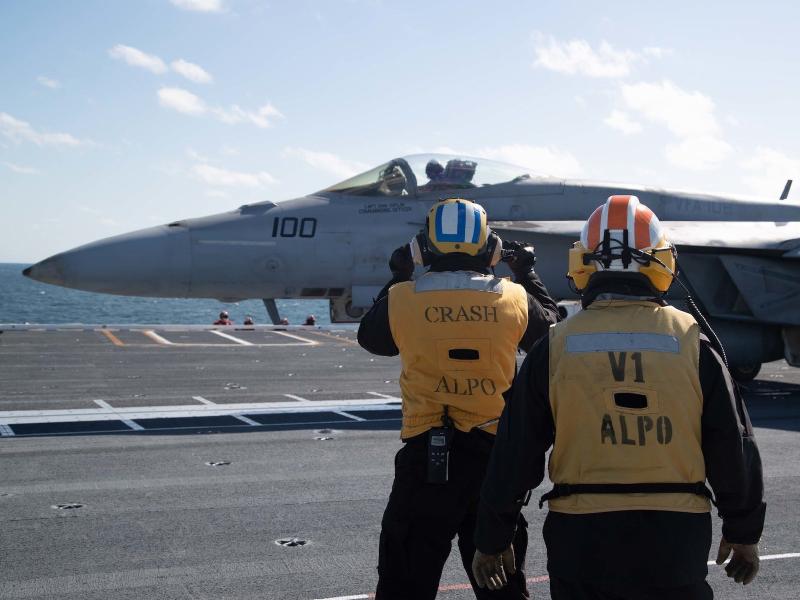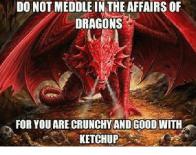How a pilot who's landed on 6 different classes of aircraft carrier prepared to land on the Navy's newest flattop
By: insider@insider.com (Courtney Mabeus) 11 hrs ago (MSN)




 © US Navy/MCS3 Brett Walker Sailors aboard USS Gerald R. Ford direct Capt. Cassidy Norman in an F/A-18E Super Hornet on Ford's flight deck, October 31, 2020. US Navy/MCS3 Brett Walker
© US Navy/MCS3 Brett Walker Sailors aboard USS Gerald R. Ford direct Capt. Cassidy Norman in an F/A-18E Super Hornet on Ford's flight deck, October 31, 2020. US Navy/MCS3 Brett Walker
- When Navy Capt. Cassidy "Dudley" Norman landed an F/A-18E Super Hornet on the aircraft carrier USS Gerald R. Ford in October, he entered rare company for a Navy aviator.
- With the Ford, Norman has now landed on aircraft carriers of six different classes. That's not a common accomplishment, and it's one that's given him a front-row seat to the evolution of the Navy's flattops.
- Visit Business Insider's homepage for more stories.
As Navy Capt. Cassidy "Dudley" Norman prepared for his first landing on the aircraft carrier Gerald R. Ford, he did what any civilian looking to beef up some skills might do.
Norman, a naval aviator for more than a quarter-century, turned to YouTube.
"I came home and looked up YouTube videos to see if I could see the approach onto USS Gerald R. Ford from the cockpit of a plane that's coming in to land so I could actually see it, you know?" Norman said in a phone interview with Insider. "I found a couple, but none that were perfect."
Norman already knew of Ford's many upgrades from the Nimitz class, including its advanced arresting gear to trap landing aircraft and the replacement of steam catapults with an electromagnetic system that the Navy has touted as revolutionary.
 © U.S. Navy photo by Mass Communication Specialist 2nd Class Ryan Litzenberger USS Gerald R Ford. U.S. Navy photo by Mass Communication Specialist 2nd Class Ryan Litzenberger
© U.S. Navy photo by Mass Communication Specialist 2nd Class Ryan Litzenberger USS Gerald R Ford. U.S. Navy photo by Mass Communication Specialist 2nd Class Ryan Litzenberger
Ford also looks different. Its "island," or command tower, sits 140 feet aft, or back, from its mid-ship location on Nimitz-class carriers.
"Compared to the other ships that island is way back there," Norman said. "When you're landing, I'm used to looking down the glide slope and I see the lens and it's on the left side of the runway, and the tower is exactly across it on the right side, kind of a balanced picture. So I was concerned that when I looked at the Ford, I was going to try to fly the plane so that I landed by the tower."
Norman completed four traps and two touch-and-goes to qualify on Ford in late October as a member of the Virginia Beach-based Strike Fighter Squadron 106, a fleet replacement squadron known as the "Gladiators."
Those qualifying flights catapulted him into a new class that few other naval aviators can likely claim: He's trapped on six classes of super carriers.
 © US Navy/MCS3 Brett Walker Norman lands an F/A-18E Super Hornet aboard USS Gerald R. Ford, October 31, 2020. US Navy/MCS3 Brett Walker
© US Navy/MCS3 Brett Walker Norman lands an F/A-18E Super Hornet aboard USS Gerald R. Ford, October 31, 2020. US Navy/MCS3 Brett Walker
Norman has accumulated more than 3,000 flight hours and 702 traps over his career.
He's humble about his accomplishment, pointing out that others have more flight hours and traps and adding that he's benefited from timing. He was aware of only one other naval aviator who had snagged a similar feat, but that person has retired and is now flying commercially.
Still, it appears that Norman may have joined a rarified, unofficial club.
While the Navy doesn't track traps by carrier classes, as many as seven individual carrier classes have operated at the same time during the jet age, National Naval Aviation Museum historian Hill Goodspeed told Insider in an email.
'So flexible and so adaptable'
 © US Navy/MCS2 Mason Gillan Norman, then USS Harry S. Truman's executive officer, delivers a final speech prior to pulling into port in Norfolk, Virginia, July 25, 2017. US Navy/MCS2 Mason Gillan
© US Navy/MCS2 Mason Gillan Norman, then USS Harry S. Truman's executive officer, delivers a final speech prior to pulling into port in Norfolk, Virginia, July 25, 2017. US Navy/MCS2 Mason Gillan
Norman's experience has given him an unexpected front-row seat to the evolution in aircraft carrier construction and aviation.
Norman, a Texas native, was working as an engineer at NASA's Johnson Space Center when he decided to pursue a career in naval aviation. He received his commission in 1993.
He qualified on the USS Abraham Lincoln, a Nimitz-class carrier, before receiving his first assignment to the Japan-based USS Independence, a Forrestal-class carrier commissioned in 1959.
Independence was already cruising when he flew out to join the crew. The air wing was practicing recoveries without radio communications or landing signals and he lined up too close on his first attempt at landing. He adjusted quickly.
"It was a small ship, so it was very amazing to see the choreography on the flight deck to orchestrate all the different aircraft both launching and then landing," he said.
 © US Navy An F-14A Tomcat launches from USS Independence, March 10, 1996. US Navy
© US Navy An F-14A Tomcat launches from USS Independence, March 10, 1996. US Navy
After Independence, the carriers Norman served on "generally have grown in size." In addition to Independence, he has flown from USS Kitty Hawk, USS John F. Kennedy, and USS Enterprise, each of their own namesake classes, as well as several Nimitz-class carriers.
"The great thing about the Navy is we have continued to design aircraft carriers so that they work very well, and if you're a Navy pilot on one class of carrier, and you need to, say, help out another squadron temporarily, go fly out to a place where that aircraft carrier's deployed, you can pick up and you can land on that ship right away," Norman said. "You don't need any training because they all use the same basic concepts and basic skills, which is really good. That's one of the reasons our naval aviation is so flexible and so adaptable."
Ford was built to be adaptable as new technologies emerge. The noticeable absence of steam on the flight deck wasn't "a big deal," Norman said.
"It's almost like a when you first heard an electric car pull up to a stop and then take off and you didn't hear any motor," Norman said. "You're like, 'what is that?' It was a very different experience."
Gone is the "big slam" and initial jolt of acceleration from the steam catapults, Norman said.
"Electronically, it's different," he said. "It's probably a smoother acceleration but when you're used to steam, it feels like the acceleration is really strong in the end. Right before you go over the edge of the ship, it feels like a kick in the pants. It feels stronger because it's so much stronger in the end."
 © US Navy/MCS1 Kyle Steckler Norman, then outgoing commanding officer of Blue Ridge-class command-and control-ship USS Mount Whitney, departs after a change-of-command ceremony, June 15, 2020. US Navy/MCS1 Kyle Steckler
© US Navy/MCS1 Kyle Steckler Norman, then outgoing commanding officer of Blue Ridge-class command-and control-ship USS Mount Whitney, departs after a change-of-command ceremony, June 15, 2020. US Navy/MCS1 Kyle Steckler
Capt. Josh Sager, commanding officer of Carrier Air Wing 8, which is embarked on Ford, flew with Norman on Kitty Hawk. Sager, who has flown from five carrier classes, called Norman's accomplishment "really cool."
"He's a great American, and I'm proud of him for that," Sager said.
Norman is scheduled to take command of the USS John C. Stennis on December 31. Though he has deployed aboard Stennis previously, Norman has not flown from the carrier, nor is he likely to.
He will be responsible for leading it to Newport News Shipbuilding in 2021 for its midlife nuclear refueling, known as Refueling and Complex Overhaul, a process that typically takes four years.
Norman's next challenge is relaying to the Stennis' crew the importance of that shipyard period.
"You have to be an integral part of that shipyard team," Norman said. "My challenge will be making sure that I get the folks on my crew the experience they need because they won't be going out to sea on our ship."
more photos here

 Article is LOCKED by moderator [Split Personality]
Article is LOCKED by moderator [Split Personality]




No politics
I had the absolute delight to spend a day at sea on the "Bad Penny", the Stinkin' Lincoln, CVN-72.
My next door neighbor in base housing was the Engineering Officer
We inspected her from the bilge to the Eagles Nest, observed non government issued air conditioners and carpeting in certain quarters,
all necessary we were told, to beat the Lincolns sister ships' tonnage.
Pretty sure that was the day my son chose the Corps and my daughter chose the USAF ( it's so much easier to land on a planet )
Good times...
Good article, great pilot.
Kudos
My great-nephew is an Air Traffic Controller at Luke AFB in AZ.
The last time I talked to him he said he is volunteering to become a ''Combat Air Traffic Controller''. I said to him, son you are entering a whole new world and you have no idea of what you're volunteering for. (secretly I'm very proud of him and hope that he is selected and makes it through)
Interesting. Thanks.
Ha ! must have been a bad time to publish, lol.